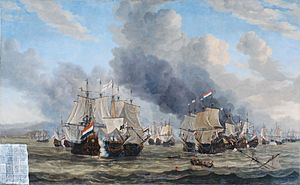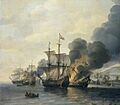Battle of Leghorn facts for kids
Quick facts for kids Battle of Leghorn |
|||||||
|---|---|---|---|---|---|---|---|
| Part of the First Anglo-Dutch War | |||||||
 The Battle of Leghorn, 4 March 1653 by Reinier Nooms, painted mid-17th century |
|||||||
|
|||||||
| Belligerents | |||||||
| Commanders and leaders | |||||||
| Henry Appleton Richard Badiley |
Johan van Galen (DOW) | ||||||
| Strength | |||||||
| 15 warships | 16 warships | ||||||
| Casualties and losses | |||||||
| 2 ships sunk 3 ships captured 150 dead or injured 50 captured |
Unknown | ||||||
The Battle of Leghorn was an important naval battle. It happened on March 4, 1653, near Leghorn (today called Livorno) in Italy. This battle was part of the First Anglo-Dutch War. The Dutch fleet, led by Commodore Johan van Galen, won against an English fleet. The English fleet was split into two groups, led by Captain Henry Appleton and Captain Richard Badiley.
Contents
Why Did the Battle of Leghorn Happen?
In 1652, England thought the Dutch navy was weak. So, England split its navy into two parts. One part went to the Mediterranean Sea and the other stayed in home waters. This was a mistake. The English fleet in the Mediterranean faced big problems.
Captain Appleton's group of six ships was stuck in Leghorn. A Dutch fleet of 16 ships was blocking them. Meanwhile, Captain Badiley's group of eight ships was at Elba, another island.
What Happened During the Battle?
The English captains knew they needed to combine their ships. But Captain Appleton sailed too early. He started fighting the Dutch before Captain Badiley could arrive to help.
The battle was tough for Appleton's ships. Three of his ships were captured by the Dutch. Two more were destroyed. Only one English ship, the Mary, was fast enough to escape. It managed to join Captain Badiley's group.
When Badiley arrived, he saw the last of Appleton's ships being captured. His fleet was much smaller than the Dutch fleet. Because they were outnumbered, Badiley's ships had to retreat. They went back to Porto Longone to be safe.
Who Won and What Happened Next?
The Dutch won the Battle of Leghorn. This victory gave them control of the Mediterranean Sea. It meant they could easily stop English trade in the Levant region.
Sadly, the Dutch commander, Johan van Galen, was badly hurt during the battle. He died a few days later on March 13.
An interesting fact is that one of the Dutch captains in this battle was Cornelis Tromp. He was the son of a famous Dutch admiral, Maarten Tromp. Cornelis Tromp later became a famous admiral himself.
Ships That Fought in the Battle
Both the Dutch and English navies used many ships in this battle. These ships included warships and also merchant ships that were hired for the war.
Dutch Ships
The Dutch fleet was led by Commodore Johan van Galen. They had about 16 ships. Some of these were powerful warships, and others were merchant ships that had been armed for battle.
English Ships
The English had two groups of ships. Captain Henry Appleton's group had six ships. Captain Richard Badiley's group had eight ships. Like the Dutch, they used a mix of warships and hired merchant ships.
Images for kids
-
The Battle of Leghorn, painted by Johannes Lingelbach.




